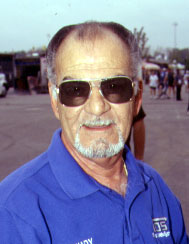 |
|||
|
|
|
||
 |
|||
Dear Pro Mod Wad, We run a 615 c.i. BB Chevy with Enderle bird hat tunnel ram induction system on alky in a 1900 lb dragster. Last year we added an NOS Pro Shot alky fogger to the system. Both systems use a common fuel cell with the N2O having its own fuel system. What’s you opinion about alky/N2O combination? After 2 seasons of fighting very rich mixtures, low e.t.’s and contradicting or nonexisting tech help from NOS, is this a viable combo to pursue? Also, what would be needed to switch this fogger system to gasoline, other than separate fuel tank & required jetting changes? (Again, contradicting info from NOS.) Other "experts" are telling us that alky/N2O don’t work and we should make the switch. No slamming or flaming NOS; just sign me "confused." Thanks for any info (Jere from Tootsees race cars said you could help.) Ken Huffman Dear "Confused," Yours is a very typical situation with alky and N2O. The problem is that both are very COLD fuels. The alky does not get a chance to break up or atomize completely due to the amounts of fuel required with alky to create the power levels you wish. In order to make hp the engine must be able to make heat and when the fuel does not burn, no heat! I have worked with racers and come up with good alky/N2O tune-ups—as long as the weather stays constant. But with a temperature or humidity change, "Bam!" Goodbye tune-up! Really, the simple solution is to get the engine sharp on alky and use racing gas with the N2O system. Compression ratios and timing are also more forgiving in this combo as you can run more of each if need be. You will be able to get and keep your tune-ups constant no matter what the weather does because your engine will create the necessary heat with race gas. You really need only to put a fuel cell for gas and change jetting to suit the tune-up for your engine. The alky solenoids can be used, but be aware there is more flow rate in these solenoids, so your fuel jetting must be addressed accordingly (as in probably less of a jet spread between N2O and gas). Sorry for any confusion or contradictions in the past. Thank Jere at Tootsees for the vote of confidence. Good luck and have fun! Pro Mod Wad Dear Pro Mod Wad: I was recently reading a discussion on one of the bulletin boards about types of piston rings N2O motors should have. The debate was whether or not to run gapless seconds. What type of rings will most benefit an all-out N2O motor? Why? Thanks, — Adam Fuller Regards, Adam: The N2O piston ring debate continues!!! In many discussions with N2O engine builders and racers, there are varied opinions. The most common answer heard about gapless or Z-gap rings is that they give false compression reading and leakdown test results. There could be piston or ring damage, but it will not show up until it’s too late! Some also feel that any fuel that gets by the top ring gets trapped and explodes or hydraulics, doing piston damage. Also, if rings and pistons get too hot and expand, this can also cause ringland damage due to the fact that rings bind in the cylinder bore. I find that a pretty standard ring combo in an N2O engine is usually a .043 tool steel top ring, 1/16 standard cast second, and high tension oil ring. End gaps vary from .034 to .052 depending sometimes on the weight of the car and demand on the engine and heat that will be processed. My advice to you is to go with the proven package. Thanks for the mail. Good luck. — Pro Mod Wad Hi, I have spoken with NOS many times. I have a 4 cyl FWD car that has a direct port "fogger" style system. I asked the tech man what 100 hp would be with four nozzles. He asked what fuel psi, which is understandable. I told him 7 psi "open flowing." He told me to use a 28n and a 26g jet. My question is, what formula did he use to determine the jet sizes? Is there a standard formula for figuring hp on a direct port nozzle system or were these numbers he gave me based on dyno testing. Any help would be appreciated. Thanks, Craig Marsh Hi Craig, Actually the answer to your question is in two parts. 1. There is a formula for figuring hp in a nozzle system. By using pound per hour fuel and N2O flows at given ratios you can figure hp per nozzle. The formulas that are used are many and they are available in the S.A. Design Book #SA 50. This book can be purchased from NOS or any of its dealers and is called "Nitrous Oxide Injection Systems for Max HP." 2. We also do run the systems on the dyno to verify that these numbers and ratios are correct and we record jets sizes for our instruction books and tune-up guides on the tech lines. These guides are also printed in the book. Hope this helps. Pro Mod Wad
|
|||
|
Copyright 1999, Drag Racing Online and Racing Net Source |
|||
